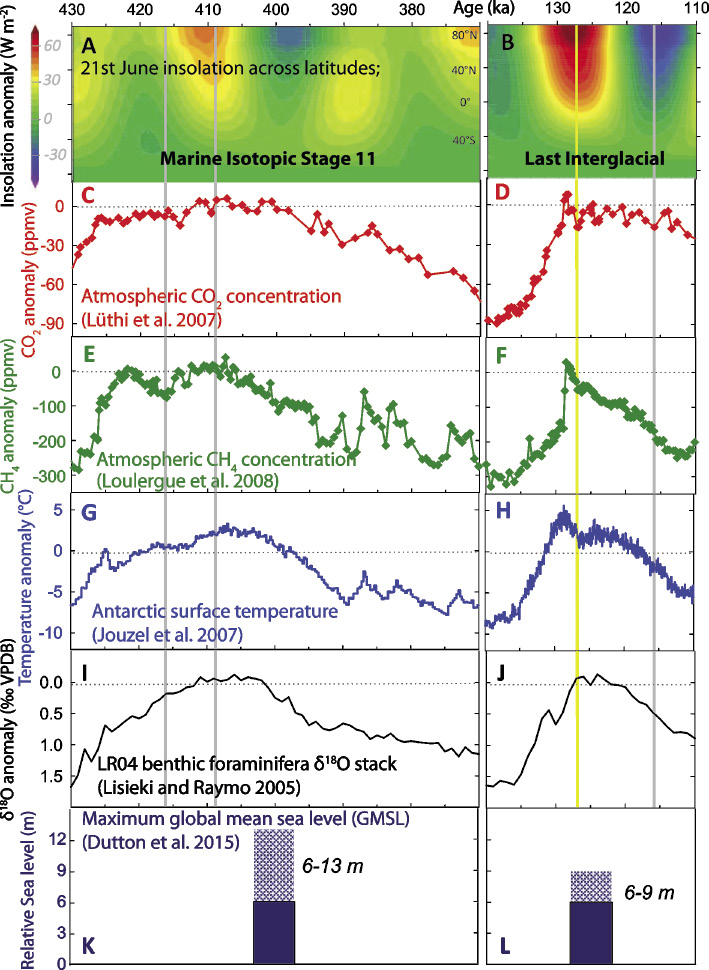- Home
- Publications
- PAGES Magazine
- Paving The Road For Improved Integrative Investigations of Past Warm Extremes
Paving the road for improved integrative investigations of past Warm Extremes
Capron E, Govin A, Bakker P, Hoffman JS, Holloway M, Moseley G & Stone EJ
Past Global Changes Magazine
24(1)
34
2016
Emilie Capron1,2, A. Govin3, P. Bakker4, J.S. Hoffman4, M. Holloway1,5, G. Moseley6 and E. J. Stone5
Cambridge, UK, 9-11 November 2015
The Last Interglacial (LIG, ~129-116 ka) and Marine Isotopic Stage 11 (MIS 11, ~424-374 ka) stand out as warm interglacials in the context of the last 800 ka (PIGS Working Group 2016). During the first workshop of PAGES’ Quaternary Interglacials (QUIGS) working group, a multi-disciplinary group of 31 delegates assessed the current knowledge and research needs on the temporal and spatial patterns of climate forcing, responses and feedbacks during these warm extremes.
Presentations and discussions around recent work (new climate proxies and paleoclimatic records, data syntheses, and climate simulations) outlined known features of the LIG and MIS 11 climates. Overall, the LIG was characterized by sea level 6-9 m higher and warmer temperatures than present-day almost everywhere over the globe. However, peak warmth did not occur synchronously across the globe and it is unlikely orbital forcing explains the observed warmth at all locations. During MIS 11, sea level reached 6-13 m higher than present day and many locations experienced prolonged warmth. Still, the magnitude and drivers of enhanced warmth during LIG and MIS 11 remain unclear.
The workshop also identified current limitations, critical missing datasets and research needs for both interglacials. We need to move toward quantitative estimates of MIS 11 and LIG global warmth and spatio-temporal climate evolutions, via new data compilations and advanced model-data comparisons. Future data syntheses should (1) better assess the seasonality of proxy records to improve interpretation of temperature reconstructions, (2) use robust and coherent chronologies amongst climatic records derived from different archives and a full integration of uncertainties on ages and tracers, (3) better integrate terrestrial records, and (4) be extended to parameters other than temperature (e.g. isotopic tracers). The latter is particularly important, since a number of climate models now have the ability to explicitly simulate climate proxies. Finally, diagnosing unambiguously the state of the Antarctic and Greenland ice sheets during these warm extremes remains a major challenge essential to assess their respective contribution to the recorded higher sea levels.
Setting guidelines for climate simulations to be performed during Phase 6 of the Coupled Model and Ice Sheet Model Intercomparison Projects (CMIP6, ISMIP6) and Phase 4 of the Paleoclimate Model Intercomparison Project (PMIP4) were also discussed. The coordinated CMIP6/ISMIP6/PMIP4 core simulation will be run at 127 ka, which was identified as the most appropriate time interval to determine LIG climate responses and feedbacks to strong insolation forcing (Fig.1). Simulated climate will be compared to data time series between ~128-125 ka to account for delays in climate responses as well as age uncertainties. The 127 ka experiment design will be detailed in a paper to be submitted later in 2016 to the Climate of the Past CMIP6 special issue. Additional sensitivity simulations will be performed within PMIP4 e.g. (1) 127 ka snapshot simulations will investigate the effect of (i) Heinrich event 11 freshwater input and (ii) an early West Antarctic Ice Sheet collapse, (2) a 116 ka snapshot simulation to explore glacial inception processes, (3) MIS 11 snapshot simulations at 416 ka and 409 ka.
The next QUIGS workshop in October (http://pastglobalchanges.org/calendar/upcoming/127-pages/1592-2nd-quigs-wshop ) will focus on the timing and shape of glacial Terminations.
affiliationS
1British Antarctic Survey, Cambridge, UK
2Centre for Ice and Climate, University of Copenhagen, Denmark
3Laboratoire des Sciences du Climat et de l’Environnement, Gif-Sur-Yvette, France
4Oregon State University, Corvallis, USA
5School of Geographical Science, University of Bristol, UK
6University of Innsbruck, Austria
contact
Emilie Capron: capron nbi.ku.dk
nbi.ku.dk
references
Bazin L et al. (2013) Clim Past 9: 1715-1731
Dutton A et al. (2015) Science 349, doi: 10.1126/science.aaa4019
Jouzel J et al. (2007) Science 317: 793-796
Lisiecki LE, Raymo ME (2005) Paleoceanography 20, doi:10.1029/2004PA001071
Lüthi D et al. (2008) Nature 453: 379-382

